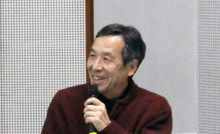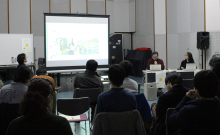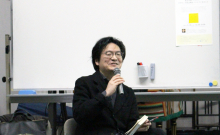The 5th Design Fundamentals Seminar “Forming Society: Design becoming a social process”
The focus of design has been widening to include “society”. Designs that have given shapes to artifacts, such as visuals, products, architecture and the environment, have extended their scope to form new connections with people and new forms of work resulted from them. In line with this phenomenon, activities whereby “one creates the society in which one desires to live in” are springing up everywhere in Japan. Let us turn our thoughts to the resulting design, where citizens, not designers, create society.
Lecturer
Takeshi Sunaga
After graduating from the Three Dimensional Design Department at Tama Art University, he worked at the GK Industrial Design research facility. He ventured away from the design field, attending graduate school at the University of Tsukuba with an interdisciplinary program combining cognitive science and design, and he completed his doctorate at the University of Tsukuba in 1987. He researched at Illinois Institute of Technology, Tama Art University, and Stanford University, and in 1998 he established the Information Design Department within the Art Department at Tama Art University. Since 2015, he has worked as a design professor in the Art Department at Tokyo University of the Arts.
Date
January 25th, 2019 (Fri) 16:30-18:30
Venue
Kyushu University Ohashi Campus, 1F Acoustic Research Center, First Floor, Recording Studio
Review
“Existence precedes essence” is one of Sartre’s most famous quotes. This quote essentially means that before there is any explanation at all, a human being’s life already exists, and all statements regulating that essence come after the fact. Sunaga expresses this idea by saying, “The process of creation does not exist if it does not create.” Throw yourself into a situation and make something, even if you do not know what is going on. Only after that can you begin to express yourself in terms of your intentions and the process used to create it.
Mr Sunaga says that what distinguishes design from other “making” depends on this expression, that is, the rationale of “the essence” of his work. If this is taken as a condition for design, then design itself expands from being the work of a specialist to something that encompasses the abilities of people everywhere. In other words, that ability lies in knowing why you are doing something. A design specialist is thus a technician who draws out that ability that is inherent in people and thinks together with those people.
In that sense, a designer is a tough amateur. There is asymmetry in the relationship between a doctor and a patient. There is a form of micro power at work. Both parties, without realizing it, “create” this type of relationship. The job of a designer is to encourage people to visualize what has been created, to express in easy to understand terms why such a relationship was created, and to consider how the relationship can be improved for both parties. It is about encouraging action, and in that sense, a designer is an activist.
The foundation of modern design is to plan, then to go about expressing that preconceived plan. The first step is to stipulate the essence, and only after that does one create the existence. This process denies existence that lacks essence. This type of planning imposes artificial restrictions on the life of a person.
Conversely, Sunaga’s design existentialism starts with the presence of a person’s life, and that existence is taken as a prerequisite. When people are happy to live “now”, it further strengthens people’s self-affirmation, which is a merit that is created by design. This is what he means when he says, “First of all, society is already there. Design is about improving it.”
(KOGA Toru)



